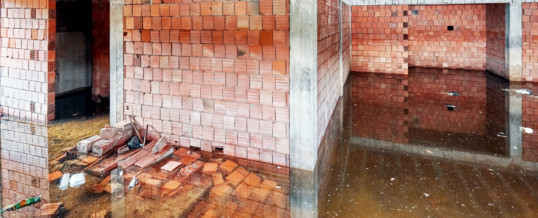
Don’t let a wet basement ruin your plans for a rec room, family room, or home theater! Sadly, that’s what many homeowners do when they realize they have a basement prone to flooding.
Many homeowners don’t realize they can take a few relatively simple steps to tame the water coming into the basement. Through several different methods of basement waterproofing, you can deal with basement drainage.
Why not conquer the flood and enjoy everything your basement has to offer?
Take a minute and read our answers to common questions about basement waterproofing. We’ll share a few reasons why basements take on water. Then, we’ll talk briefly about a few waterproofing options you can take advantage of now!
Why Do Basements Flood?
First, it’s not only major flooding homeowners should worry about. It’s also the excess moisture from seepage and high humidity levels. Any moisture in a basement can render it unusable.
Flooding or dampness in a basement can happen during both the dry and wet weather. In this post, we’ll talk solely about excess moisture during wet weather since that’s most common. After all, anytime you have heavy rain, snowmelt, or ground thaw, there’s a heavy load on your drainage system.
Since water always follows the path of least resistance, the basement bears the brunt of any excess. Water may enter your basement through any of the following:
- Surface Inflow
- Faulty Foundation Drainage
- Sump Pump Failure
- Seepage
- Basement Tile Deterioration
All of these causes of a wet basement have solutions. With proper grading, you can avoid water accumulation around your foundation. While not considered a waterproofing method per se, grading does help prevent water from entering your home due to surface inflow.
Professional waterproofing will help take care of most other basement drainage issues.
Is There More than One Waterproofing Method?
Basement waterproofing methods include using sealants, coatings, and either interior or exterior waterproofing.
Sealants prevent the walls and floors from absorbing moisture. They’re not the ideal way to manage basement drainage. At best, sealants are a temporary tool to help keep a basement dry.
The most expensive (and intrusive) method is exterior waterproofing. This method requires extensive excavation around your home all the way down to the full depth of your foundation. Exterior waterproofing usually entails a drainage panel, an exterior French drain, and possibly, a sump pump.
The ideal time for exterior waterproofing is during the home’s construction.
Considered the most effective waterproofing method, installing an interior water drainage system is one of the best solutions for your wet basement. Next, we’ll show you why.
How Does Interior Basement Waterproofing Work?
First, keep in mind, you’ll always have groundwater. The age of a home has nothing to do with the presence of groundwater. Because it’s there doesn’t mean the crew that built your home didn’t do a proper job.
You can’t make groundwater dry up, but you can work with it so that it doesn’t seep up through your concrete floor and walls and cause damage to your home.
Waterproofing uses a drainage system installed in your basement floor. This system, called a pressure relief system, moves water away from the interior of your home through a series of drains. The drains constructed from perforated pipes sit in trenches dug around the interior perimeter of your basement.
An interior drainage system works together with a sump pump to pump out any excess water.
What About My Basement Windows?
Basement windows let in much-needed light and fresh air. If you’ve installed egress windows, they serve as an escape route.
The windows in a basement can also let water seep into your basement through the window wells. Unless you install window well drains, you will deal with water at some point.
In some cases, a builder takes a short cut and doesn’t install window well drains. If that’s the case with your home, your best solution is to go ahead and install the drains. Window well drains connect to either your interior or exterior drainage system.
Consider installing them at the same time you install your interior waterproofing system.
Is Basement Waterproofing Intrusive?
Remember above when we talked about different waterproofing methods? Both the exterior and interior methods do require some excavation. Here’s how the interior waterproofing process works.
Your contractor will need to dig a trench in the basement floor. Usually, the trench is only 4-18 inches wide and goes around your basement’s perimeter.
The contractor then places the drainage pipes we mentioned earlier in the trench. The drainage pipes move the water to a collection area called a sump pit. Then, a sump pump sucks the water from the pit and discharges it outside of your home.
Don’t worry that you’ll end up with an open trench. Your contractor will cover the trench appropriately depending on how you plan to use your basement.
Why Can’t I Just Use Sealants?
Keep in mind the way sealants work. They seal cracks in the walls and help prevent seepage. Sealants don’t remove groundwater from underneath your basement floor.
Many contractors use a multi-prong approach to waterproofing basements. They may use a combination of vinyl liners, sealants, waterproof coatings, and an interior drainage system.
Before you make a decision about which method you prefer, make sure you meet with a contractor who can go over each option in detail with you. The structure of your home, its location, and your unique water issues all determine which waterproofing method will work best for you.
Need Help with Basement Drainage?
We hope this post answered your questions about basement drainage and some of your options for dealing with excess moisture. Don’t allow a wet basement to put a damper on your ability to enjoy your entire home, basement included.
Whether you choose sealing cracks, removing groundwater before it enters your basement, or you decide on a combination of methods, we’re here to help. Contact us today and let’s schedule a free inspection.
ShareJAN
